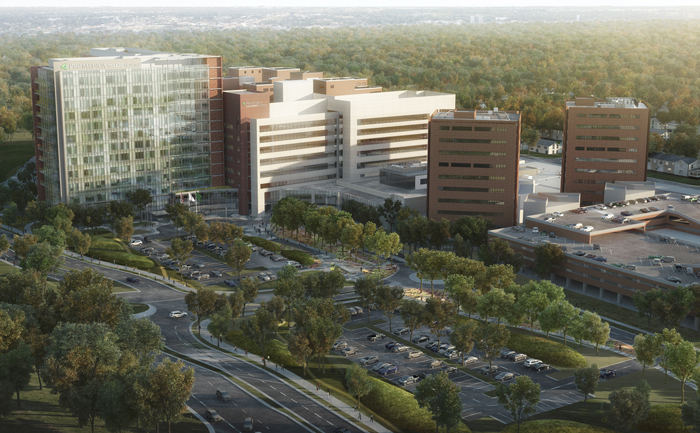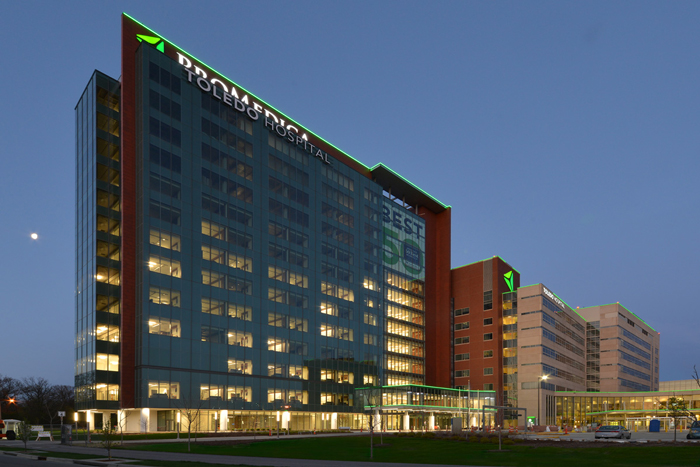
As published in Toledo Business Journal - June 1, 2019

Rendering of ProMedica’s Generations of Care project
ProMedica Toledo Hospital is set for Phase II of its $385 million Generations of Care project, which is currently under budget and ahead of schedule. The first phase of the project – a 13-story, 600,000 square foot facility called the Generations Tower that holds over 300 beds and a new underground parking garage with an additional 350-400 parking spots – has been completed. The second phase – occupying the main tower and a 60,000 square foot renovation of the existing hospital – is ready to take place starting in July.
Construction on the project began in late 2015 and is expected to be complete by May 2020. Lathrop is the project manager and HKS out of Novi, Michigan, is the architect.
“After the hospital moves into the new Generations of Care Tower, we will be changing an existing adult floor to a pediatrics floor in the Renaissance Tower – level 8 specifically. Then we’ll be doing some modifications on level 2 around some existing ICU suites to accommodate the new building tie-in as well. This work is scheduled to start in July,” said Bill Kidd, project manager for Lathrop.
According to Rob Vela, project manager, system construction management for ProMedica, the 8th floor to move into the Generations of Care Tower is an adult floor and is on the first level of the tower. Vela explained that there will be adult floors, a few pediatric and women floors (antepartum and post-partum floors), a nursery, and a neonatal abstinence syndrome (NAS) floor, among others, in the new tower.
Vela also noted that the top four floors of the tower were shells to accommodate for future growth.
“That’s 20,000 square feet per floor, 40 beds per floor. We have the potential expansion of 160 beds if we were to fill up all of those floors,” said Vela.
When speaking of the floor plans for the Generations of Care tower and the efficiencies within, Vela said, “The Generation’s floor plans are a mix of acuities and the same disciplines. So you’ll have a neuro-ICU and a neuro step down on the same floor. This gives us efficiencies with nursing staff and physicians so they’re only staying on one floor as opposed to running across the hospital and down an elevator to get to a different wing of the hospital.”
ProMedica previously explained to the Toledo Business Journal that there was a lot of thought that went into the efficiency of the layout of the rooms and it’s expected to be much more efficient for its doctors, nurses, patients, and families. Through the design of the Generations Tower, the number of miles a nurse walks every day has been reduced and, according to ProMedica, each floor will have a wing of ICU and medical surgical beds, as well as sunrooms, which are intended to be gathering places for families. On top of that, every room is going to be private with a lot of glass for natural light, which also helps healing, noted ProMedica.
Within the new Generations of Care tower, as well as in the existing hospital, ProMedica is adding a range of new technology.

Progress on the Generations of Care Tower
According to ProMedica, one of the big things the hospital is adding is called ‘smartroom technology.’ Smartroom technology will be equip the nurses caring for patients with a handheld device that will be linked through ProMedica’s IT infrastructure, meaning every nurse can walk the halls and be connected to all of their rooms and patients – both at the same time – to know what their patients are doing from a clinical perspective. This new feature is helping ProMedica create a definition of care for the next generation and is helping the organization recruit and retain talent, as this is a new leading technology.
“We’re also looking at a cell phone application that allows us to receive alarms and critical labs directly to the caregiver’s cell phone, so we can keep contacts with those patients even when they’re not in the room,” said Vela.
As for the energy efficiency of the building, Kidd explained that everything is up to the latest energy codes.
“There is LED lighting everywhere, temperature control systems that will only provide what is truly needed for the space when the space is occupied, but that’s more commonplace in the healthcare market. But it’s definitely up to the latest code and compliance standards,” said Kidd
A project of this magnitude and of significant investment takes a lot to run smoothly. According to Kidd and Vela, there were a few factors that allowed the project to be under budget and ahead of schedule, including pre-fabrication, pre-planning efforts, and the overall team working on the project.
When speaking of the pre-fabricated materials and how it benefitted the process, Kidd explained, “We pre-fabricated the mechanical racks, which was the biggest success story we’ve had. The racks were all constructed in a warehouse about three miles away from the site while we were erecting the building steel. That allowed us to have them built in a conditioned environment, inspected by local officials, and then we were able to cut them in transportable pieces 18-20 feet long, put them on a semi trailer, and bring them to the hospital and lift them into place as one big unit versus bringing individual parts piece by piece. Different parts of the bathroom utilities could be pre-fabricated, like drain assemblies and water supply lines.”
Vela mentioned the pre-planning as a significant benefit to the project.
“A big portion of this project was the pre-planning efforts – the estimating, the scheduling, etc. – well before we put a shovel in the ground. We had a lot of plans already in place as to how things were going to work. Lathrop’s sensitivity to the hospital – understanding hospital operations, how to work inside a hospital, how to maintain our patient flow – was important to us. Then, obviously they have a great name, so they were able to take the best subcontractors to fill out the teams to make this a successful project,” said Vela. “We worked hand-in-hand to schedule all the work that did impact our existing hospital. Some of the solutions included after hours work and sometimes we temporarily relocated a couple of units and moved them back when we were done with the work, or we’d even shut down a couple units for a small period of time to allow us to do the work. But overall, we worked hand-in-hand to make sure that those schedules aligned with what Lathrop was trying to achieve.”
Kidd then explained that the subcontractors who worked on the project also helped greatly with this effort.
“We’re a big team, so everybody we had here was instrumental. From the supplier of the smallest item that we installed in a patient room to the trade partners who provide the largest components of the structure, they were all key. I think that’s been a big part of our success and how we were able to finish ahead of schedule and under budget,” said Kidd. “We assembled a great team based off of our national and local presence and they all came through for us. We worked through all the challenges that occurred on a day-to-day basis by coming up with team-based plans to deal with the challenges, and we couldn’t do it without every single one of the people we contracted with.”
Kidd noted that Lathrop oriented over 3,100 people to work on this project.